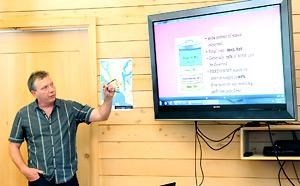Cleaning up the old waste transfer site and building a new resource recovery centre in Powell River would cost considerably less than throwing everything on a barge to Washington State, where waste is currently sent.
The interesting parts of the equation will be how to build a regional facility on city land and how the cost sharing would be divided.
Mike Wall, manager of community services for Powell River Regional District, provided an explanation at the C3 (community to community to community) meeting held on May 1. The C3 meetings are periodic gatherings between Tla’amin (Sliammon) First Nation, City of Powell River and the regional district.
Wall said there has been closure planning of the proposed site, which was previously the city’s incinerator site. One of Wall’s projects in 2014 was to work with consultants to come up with a plan. This involves healing the site, including removing or encapsulating the hazardous material.
There were insistences from the ministry of environment in moving forward. One of the stipulations was to identify an end use for the site. That determines the level of risk assessment required.
“For example, if we were to throw everything in a pile, encapsulate it, throw on some grass seed and lock the gate, it would be a very low risk assessment,” Wall said. “To make better use of the site, there is higher risk assessment required. We’ve studied some other projects that were similar and actually found one in Ladysmith.”
Wall said that project, also an incinerator reclamation site, was comparable to Powell River’s waste transfer site. Now, on the Ladysmith site, there is a high-end recycling facility that recycles more than 680 different items.
In Ladysmith, when reclaiming the property, some metals and other deleterious substances were mined out of the accumulated ash and then the neutralized ash was used as a construction material. It was rolled out to create a working surface to build the facility on. The Ladysmith site is clean and that is the local vision as well.
Wall said one of the reasons for embarking on this journey is because there is an incredible opportunity for the region. Because a great deal of solid waste is taken to Rebanco, Washington, rather than being dealt with here, there is not the problem of what to do if there was an operating landfill site in the region. He said currently, transfer to Rebanco is $205 per tonne and it is 770 kilometres one way to transport the waste. In 2014, the total cost of sending 4,604 tonnes of waste to Rebanco was nearly $1 million.
“We could do a lot better than that,” Wall said. “We could create local jobs.”
The solid waste management plan must include waste diversion and disposal activities. The local plan identifies a philosophy of working toward zero waste.
Wall said it is believed that the region could achieve 60 per cent solid waste diversion with ease. That will be started next year with the diversion of organics from the waste stream. It makes up about 40 per cent of the waste stream.
Wall said the business case for the resource recovery centre involves an approved closure plan for the old incinerator site. Options have been discussed. One is creating the recovery centre at a cost of $4.3 million. To collect everything at the site and send it to Rebanco, the estimate is $12 million.
Basic planning for the concept for phase one of the first option is working surface design, site preparation, cleanup, mining of the metals in the ash pile, surface water management and road construction. The second phase would involve the construction of the building. The total cost is estimated to be $8.5 million, which is still cheaper than packaging everything and sending it to Rebanco.
Wall said this could be the beginning of a journey toward zero waste. It would be a one-stop shop for disposal, as well as an educational centre. For Powell River, it would be an opportunity to be a continental leader in sustainable waste practices and would promote self-reliance.
Al Radke, regional district chief administrative officer, said at this point, the project is a concept. He said the province has told the regional district that it will not provide a permit for the site to be capped and abandoned.



